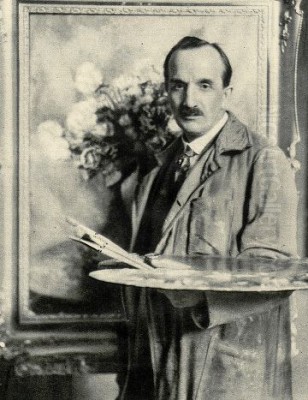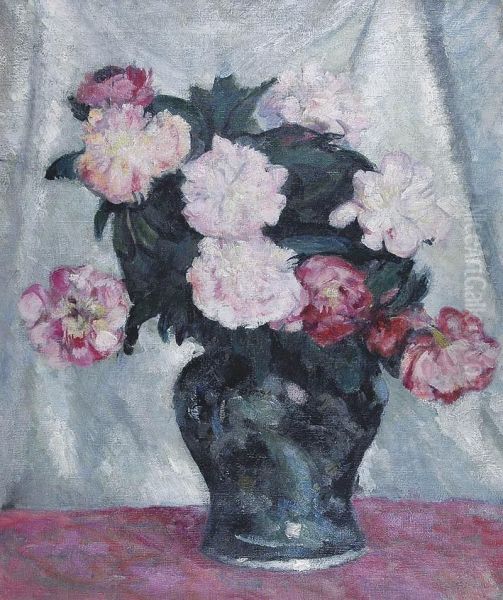
Stefan Filipkiewicz stands as a significant figure in the landscape of Polish art history. A painter deeply connected to the natural beauty of his homeland, his life and work offer a compelling glimpse into the artistic currents of the late 19th and early 20th centuries in Poland, particularly the influential Young Poland movement. His dedication to capturing the essence of the Polish landscape, especially the Tatra Mountains, combined with his tragic fate during World War II, cements his place in the annals of European art.
Early Life and Artistic Formation
Stefan Filipkiewicz was born on July 28, 1879, in the town of Tarnów, located in what was then Austrian-controlled Poland. His artistic inclinations led him to Kraków, the cultural heart of Poland at the time. Between 1900 and 1908, he pursued formal art education at the prestigious Academy of Fine Arts in Kraków. This period was crucial for shaping his artistic vision and technical skills.
During his studies, Filipkiewicz had the opportunity to learn from some of the most prominent Polish artists of the era. His professors included Józef Mehoffer, a leading figure of the Young Poland movement known for his stained glass, murals, and paintings, and Leon Wyczółkowski, another versatile artist celebrated for his realistic portraits, landscapes, and graphic works. However, the most profound influence on Filipkiewicz's artistic development came from Jan Stanisławski.
Stanisławski was a charismatic teacher and a pivotal figure in Polish modern landscape painting. He encouraged his students to paint directly from nature (en plein air) and to capture the fleeting moods and atmospheric effects of the landscape. Filipkiewicz became one of Stanisławski's most distinguished pupils, deeply absorbing his mentor's approach to landscape painting, particularly the focus on synthesis, mood, and the expressive potential of color.
The Young Poland Movement and Filipkiewicz's Style

Filipkiewicz emerged as an artist during the height of the Młoda Polska (Young Poland) movement, a vibrant period of artistic and literary flourishing in Poland roughly spanning from 1890 to 1918. This movement, akin to Art Nouveau and Symbolism elsewhere in Europe, emphasized individualism, emotional expression, and a deep connection to Polish folklore, history, and nature. Landscape painting, especially "psychological landscapes" that conveyed mood and emotion, was central to the movement.
Filipkiewicz is considered a key representative of the Young Poland style in landscape painting, particularly influenced by Stanisławski's school. His artistic style is characterized by a focus on capturing the essential beauty and specific atmosphere of the Polish landscape. He often employed simplified viewpoints and carefully constructed compositions to enhance the emotional impact of his scenes. His work sometimes aligns with the broader aesthetics of Art Nouveau through its decorative qualities and emphasis on line and form, while his approach to color and light can also show affinities with Neo-Impressionism.
Color was a vital element in Filipkiewicz's work. He skillfully used palettes that conveyed the specific light and feel of different seasons and times of day. His depictions of the Carpathian Mountains often featured soft, ethereal blues, while his winter scenes masterfully captured the subtle interplay of light on snow, rendering reflections and shadows with nuanced sensitivity. There is often a dreamlike, almost mystical quality to his landscapes, inviting contemplation.
Key Themes and Subjects
The dominant theme throughout Stefan Filipkiewicz's oeuvre is the landscape of Poland. He held a particular fascination for the mountainous regions, returning time and again to paint the Tatra Mountains and the Podhale region at their foothills. These areas, with their dramatic peaks, deep valleys, and traditional highland culture, were a powerful source of inspiration for many Young Poland artists, seen as repositories of the authentic Polish spirit.
Filipkiewicz became especially renowned for his winter landscapes. He possessed a unique ability to portray the stark beauty and profound silence of the Polish winter. Snow-covered forests, frozen streams, the crisp air of a winter morning – these were subjects he rendered with exceptional skill and sensitivity. Works like Strumień w lesie zimowym (Stream in a Winter Forest), Winter River, and depictions titled Glacier or Ice River exemplify his mastery in capturing the textures and light of the winter world.
While landscapes formed the core of his output, Filipkiewicz also engaged with other genres. He produced decorative still lifes, showcasing his refined sense of composition and color harmony. Paintings such as Kwiaty (Flowers), Piwonie w wazonie (Peonies in a Vase), or Róże w wazonie (Roses in a Vase) demonstrate his versatility and attention to detail in depicting floral arrangements. He also worked in watercolor, as seen in pieces like Chatting Hut.
Associations and Influence
Beyond his individual artistic practice, Stefan Filipkiewicz was actively involved in the cultural life of his time. He was one of the co-founders of the Zielony Balonik (Green Balloon) cabaret in Kraków. Launched in 1905 in Jama Michalika (Michalik's Den), this satirical literary and artistic cabaret became a legendary institution, known for its witty performances, puppet shows, and its role as a meeting place for the city's avant-garde artists and writers, including figures like Tadeusz Boy-Żeleński and members of the Kraków Academy circle.
His deep connection to the Tatra region is further evidenced by the inclusion of his works in the collection of the Tatra Museum in Zakopane, placing him alongside other artists dedicated to depicting this iconic landscape. His association with the Kraków Academy of Fine Arts continued beyond his student years. He returned as an educator, serving as a professor from the 1930s (sources mention 1930 or specifically 1937-1938), sharing his knowledge and influencing a new generation of artists.
His network naturally included his teachers, Jan Stanisławski, Józef Mehoffer, and Leon Wyczółkowski. As a prominent figure within the Young Poland movement and the Kraków art scene, he would have been contemporary to and likely interacted with other major figures such as Stanisław Wyspiański, the multifaceted genius known for drama, painting, and design; Jacek Malczewski, the leading Symbolist painter; Włodzimierz Tetmajer, known for his depictions of rural life; and fellow landscape painters influenced by Stanisławski or active in the period, like Ferdynand Ruszczyc, Konrad Krzyżanowski, Kazimierz Sichulski, and Wojciech Weiss. The sculptor Xawery Dunikowski was also a significant figure associated with the Kraków Academy during this era. Filipkiewicz's position as a respected student of Stanisławski placed him firmly within this influential artistic milieu.
Recognition and Legacy
Stefan Filipkiewicz achieved considerable recognition during his lifetime. He exhibited his works widely, not only in Poland but also across Europe, participating in various international exhibitions and garnering several awards for his artistic achievements. His paintings were appreciated for their technical skill, evocative power, and authentic portrayal of the Polish landscape.
Today, his works are held in important public collections in Poland. Key institutions include the Tatra Museum in Zakopane, which is dedicated to the art, culture, and nature of the region he so often painted, and the Society of Friends of Fine Arts in Kraków, a long-standing institution supporting Polish art. His paintings also appear on the art market, demonstrating continued appreciation among collectors.
Auction results provide a glimpse into the market value of his work. For instance, in 2022, paintings like Kwiaty (Flowers) and Róże w wazonie (Roses in a Vase) were estimated at auctions in Poland for PLN 20,000 to 30,000 (approximately €4,300 to €6,400 at the time). These figures reflect his established reputation as a significant Polish painter of the early 20th century, particularly valued for his connection to the Young Poland movement and his mastery of landscape.
The War Years and Tragic End
Filipkiewicz's life, like that of many of his generation, was profoundly impacted by the turbulent history of the 20th century. He served in the Polish Legions, part of the Polish military effort during World War I, from 1914 to 1917. This experience undoubtedly shaped his perspective, though his primary artistic focus remained on the timeless beauty of nature.
The outbreak of World War II brought catastrophe. Following the German invasion of Poland in 1939, the situation for artists and intellectuals became increasingly perilous under the brutal Nazi occupation. At some point during the war, Filipkiewicz attempted to seek safety by fleeing to Hungary. However, his escape was unsuccessful. He was apprehended by the Gestapo.
Stefan Filipkiewicz was subsequently deported to the Mauthausen concentration camp, one of the most notorious camps in the Nazi system, located in Austria. The exact circumstances and date of his death within the camp are grim, but it is documented that he perished there in 1944. His life was tragically cut short by the horrors of the war.
His death in Mauthausen adds a layer of profound tragedy to his artistic legacy. He became one of the countless victims of Nazi persecution, and his fate serves as a stark reminder of the devastating impact of the war on Polish culture and its creators. His work, often celebrating the serene beauty and enduring spirit of the Polish land, stands in poignant contrast to the violence that ended his life. He is remembered not only as a talented painter but also as a symbol of the resilience and suffering of Polish artists during World War II.
Conclusion
Stefan Filipkiewicz remains an important and respected painter in Polish art history. As a distinguished student of Jan Stanisławski and a key representative of the Young Poland movement's approach to landscape, he made significant contributions to the development of modern Polish art. His paintings, particularly his evocative depictions of the Tatra Mountains and winter scenes, are celebrated for their technical proficiency, atmospheric depth, and emotional resonance.
Through his skillful use of color, light, and composition, Filipkiewicz captured the unique character and soul of the Polish landscape. His involvement with the Zielony Balonik cabaret and his role as a professor at the Kraków Academy of Fine Arts further highlight his integration into the vibrant cultural life of his time. Though his promising career was brutally ended by the events of World War II, Stefan Filipkiewicz's art endures, offering a timeless vision of nature's beauty and a poignant connection to a pivotal era in Polish history. His legacy is preserved in museums, collections, and the continued appreciation for his sensitive and masterful portrayals of his homeland.